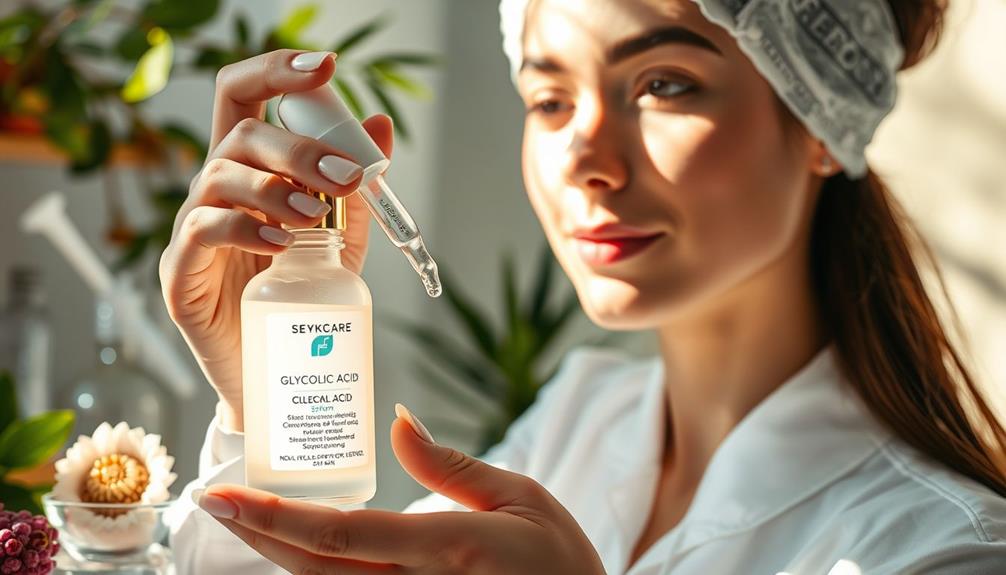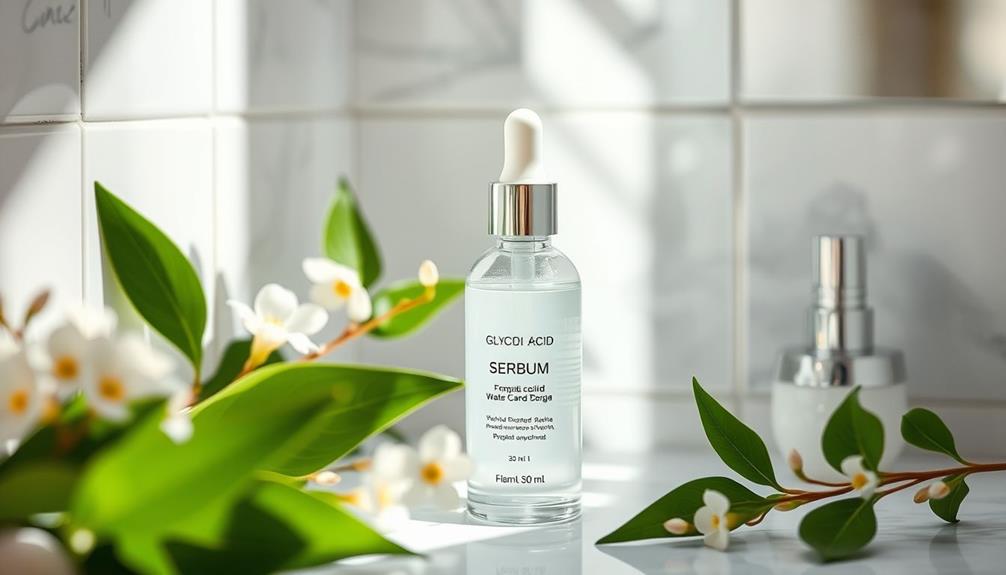Glycolic acid is a skincare powerhouse, releasing your skin's potential through deep exfoliation. It works by breaking down dead skin cell bonds, promoting smoother, more radiant skin. You'll experience improved texture, increased collagen production, and better moisture retention, making your skin firmer and plumper. Not only does it help prevent breakouts by unclogging pores, but it also reduces hyperpigmentation and promotes an even skin tone. Use it at night, starting with lower concentrations, and always apply sunscreen during the day. Curious about maximizing its benefits and avoiding potential pitfalls? There's so much more to discover!
Key Takeaways
- Glycolic acid is a powerful AHA that promotes cell turnover and improves skin texture by dissolving dead skin cell bonds.
- It enhances collagen production, resulting in improved skin elasticity and a firmer, more youthful appearance.
- Regular use helps prevent and treat acne by unclogging pores and reducing breakouts through increased cell turnover.
- Glycolic acid boosts moisture retention, keeping skin hydrated and plump for a radiant complexion.
What Is Glycolic Acid?

Glycolic acid, a powerful alpha-hydroxy acid (AHA) derived from sugar cane, is celebrated for its ability to exfoliate and rejuvenate your skin.
Its small molecular size gives it unique exfoliating properties, allowing for deeper penetration into the skin compared to other AHAs. This means it effectively dissolves the bonds between dead skin cells, promoting cell turnover and revealing a smoother, brighter complexion.
Additionally, incorporating essential oils like lavender oil can enhance your skincare routine, providing soothing benefits while addressing skin concerns.
You'll find glycolic acid in a variety of skincare products, including cleansers, toners, serums, and peels. Typically, over-the-counter formulations contain concentrations ranging from 5% to 10%.
Regular use can lead to significant skin benefits, such as improved skin texture. It works wonders in reducing the appearance of fine lines and wrinkles while also addressing issues like hyperpigmentation.
How Glycolic Acid Works

Understanding how glycolic acid works reveals its remarkable ability to transform your skin through effective exfoliation and deep penetration. Glycolic acid breaks down the bonds between dead skin cells in the stratum corneum, facilitating their shedding and promoting a smoother skin texture.
Its small molecular size allows it to penetrate deeply into the skin, enhancing collagen production and improving elasticity. Similar to how essential oils like lavender promote relaxation through their therapeutic properties, glycolic acid offers a rejuvenating experience for your skin by encouraging cellular renewal essential oils provide therapeutic benefits.
By accelerating cell turnover, glycolic acid reveals fresher, brighter skin underneath, effectively reducing the appearance of fine lines and hyperpigmentation. The exfoliating action also unclogs pores, preventing acne and improving overall skin clarity.
As a bonus, glycolic acid boosts moisture retention, increasing hydration levels and contributing to a plumper, more youthful appearance.
Incorporating glycolic acid into your skincare routine can lead to significant improvements in your skin's texture and tone. You'll notice a reduction in the visibility of imperfections and a more radiant complexion.
With consistent use, glycolic acid can be your ally in achieving smoother, healthier skin, making it a powerful ingredient in your quest for a more vibrant look.
Key Benefits for Skin

When you incorporate glycolic acid into your skincare routine, you'll notice a significant boost in radiance through effective exfoliation.
This process can be likened to the unique interplay of sound waves and light observed in phenomena such as sonoluminescence secrets, where energy is transformed into visible light.
It not only helps prevent and treat acne by keeping your pores clear but also enhances your overall skin texture.
With consistent use, you can achieve a brighter, smoother complexion that feels revitalized.
Exfoliation and Radiance Boost
Exfoliating with glycolic acid reveals a smoother, more radiant complexion by effectively dissolving dead skin cells and boosting cell turnover.
This powerful chemical exfoliant not only enhances skin brightness but also improves clarity, making your skin look fresher and healthier.
Regular use can considerably reduce the appearance of dark patches and hyperpigmentation, promoting an even skin tone.
Incorporating glycolic acid into your skincare routine can be similar to how butter enhances flavor in cooking, as both can elevate the overall quality of your skin.
Glycolic acid's small molecular size allows it to penetrate deeply into the skin, stimulating collagen production.
This helps improve skin firmness and elasticity, contributing to a youthful appearance.
As you incorporate glycolic acid into your routine, you'll notice increased moisture retention, which keeps your skin plump and hydrated, preventing dryness.
Acne Prevention and Treatment
Glycolic acid not only enhances radiance but also plays a key role in preventing and treating acne by effectively clearing away dead skin cells and unclogging pores.
By exfoliating the skin, glycolic acid helps reduce the occurrence of breakouts, making it essential for your acne prevention routine. It works to increase cell turnover, which is vital in preventing the formation of comedones, such as blackheads and whiteheads.
Higher concentrations of glycolic acid, around 10%, can greatly improve the appearance of acne-prone skin. Its antibacterial properties inhibit the growth of acne-causing bacteria, further supporting your skin's health.
Regular use can also aid in fading post-acne marks and hyperpigmentation, leading to a more even skin tone over time.
Incorporating glycolic acid into your skincare regimen can help you achieve smoother texture and minimized pore size.
Whether you're dealing with active breakouts or the aftermath of past acne, glycolic acid proves to be a powerhouse for both prevention and treatment.
Recommended Usage Guidelines

To safely incorporate glycolic acid into your skincare routine, apply it at night and start with lower concentrations to gauge your skin's tolerance.
If you have sensitive skin, begin with products containing 5-10% glycolic acid. This way, you can gradually increase the concentration based on how your skin reacts. Always conduct a patch test on a small area before applying it fully to avoid adverse reactions.
For cleansers, use a pea-sized amount once or twice daily, while toners, serums, and creams should be applied in small amounts only at night.
When using glycolic acid peels, start slow with a frequency of once a week or every two weeks. As your skin becomes accustomed to the acid, you can increase the frequency of use.
Since glycolic acid can increase sun sensitivity, it's essential to wear a broad-spectrum SPF of at least 30 during the day.
Following these recommended usage guidelines will help you maximize the benefits of glycolic acid while minimizing potential skin irritation.
Potential Side Effects

When using glycolic acid, you might encounter common skin reactions like redness and peeling, especially at first.
It's essential to take precautionary measures, such as wearing sunscreen, to protect your skin from increased sun sensitivity.
Additionally, understanding the long-term effects can help you make informed choices for your skincare routine.
Common Skin Reactions
Have you noticed any redness or irritation after using glycolic acid? While this powerful ingredient can benefit your skin, it can also lead to common skin reactions, especially if you have sensitive skin or use it at higher concentrations.
Here are some potential side effects you might encounter:
- Redness and irritation shortly after application
- Peeling, which can be more pronounced for newcomers to chemical exfoliants
- Burning sensations and swelling in some cases
It's essential to be mindful of these reactions. Patch testing is a smart way to gauge your skin's tolerance before fully incorporating glycolic acid into your routine.
If you experience severe reactions, such as blistering or intense peeling, it's best to discontinue use immediately and consult a dermatologist.
Remember, while glycolic acid can enhance your skincare regimen, understanding its potential side effects is significant for your skin's health.
Always prioritize your skin's comfort and safety when using any active ingredients.
Precautionary Measures
Understanding precautionary measures is essential for safely incorporating glycolic acid into your skincare routine and minimizing potential side effects.
When you start using glycolic acid, be aware that it can increase skin sensitivity, especially to sunlight. Always apply a broad-spectrum sunscreen with an SPF of at least 30 to protect your skin from sunburn and damage.
Common side effects include redness, irritation, burning sensations, and peeling, particularly when you first introduce glycolic acid. If you have sensitive skin or conditions like eczema, consult a dermatologist before using glycolic acid, as you may experience heightened irritation.
To avoid adverse reactions, conduct patch testing on a small area of skin before full application. This will help you identify how your skin reacts to glycolic acid.
Start with lower concentrations, ideally below 10%, and gradually increase the frequency of use as your skin builds tolerance. This approach minimizes irritation and helps you enjoy the benefits of glycolic acid without overwhelming your skin.
Long-Term Effects
Long-term use of glycolic acid can lead to increased skin sensitivity, requiring diligent protection against UV damage. As your skin adapts to this potent ingredient, it's vital to monitor for potential side effects.
You might experience:
- Irritation and redness, particularly if you have sensitive or dry skin.
- Peeling, which can be a sign of over-exfoliation.
- Hyperpigmentation, especially if you use glycolic acid excessively or too quickly.
To minimize these risks, always apply a broad-spectrum sunscreen during the day, as glycolic acid can heighten your skin's sun vulnerability.
While severe reactions like chemical burns are rare, they can occur with high concentrations or improper use, emphasizing the significance of patch testing.
Consulting with a dermatologist before starting a glycolic acid regimen is also wise.
Interactions With Other Ingredients

When incorporating glycolic acid into your skincare routine, it's crucial to be mindful of its interactions with other ingredients to maximize benefits and minimize irritation.
Using glycolic acid alongside retinol can be effective, but don't apply them simultaneously; alternating nights helps reduce irritation while enhancing their effects.
Conversely, combining glycolic acid with Vitamin C isn't recommended, as they can neutralize each other, decreasing their efficacy.
Additionally, using glycolic acid with BHAs like salicylic acid can lead to increased irritation. It's best to use these on alternate days or in separate routines.
While glycolic acid boosts exfoliation, avoid layering it with other AHAs, such as lactic acid, to maintain your skin barrier's integrity and prevent irritation.
On a positive note, glycolic acid can improve the absorption of other skincare ingredients. Incorporating it with hydrating agents like hyaluronic acid or aloe vera can yield ideal results, ensuring your skin remains moisturized and healthy.
Expert Recommendations and Insights

For ideal results, experts suggest starting with a low concentration of glycolic acid and gradually increasing it as your skin builds tolerance. This approach helps you avoid excessive skin sensitivity while maximizing the benefits of glycolic acid, such as improving cell turnover and stimulating collagen production.
Here are some expert recommendations to incorporate glycolic acid effectively into your skincare routine:
- Start Low: Begin with a concentration of around 5% for sensitive skin, then increase to 10% as your skin adjusts.
- Nighttime Use: Apply glycolic acid products at night to minimize sun sensitivity and guarantee better absorption.
- Hydrate: Use moisturizing ingredients like hyaluronic acid to enhance skin tolerance and maintain hydration levels.
Conclusion
Incorporating glycolic acid into your skincare routine can be a game changer for your complexion.
Think of it as a gentle exfoliating superhero, revealing fresher, brighter skin beneath.
With its ability to improve texture, reduce fine lines, and enhance overall radiance, it's a powerhouse worth considering.
Just remember to follow usage guidelines and listen to your skin.
Embrace the transformation, and let glycolic acid release your skin's true potential!








